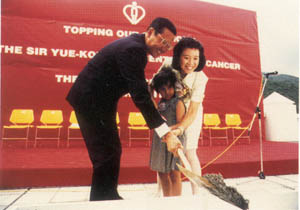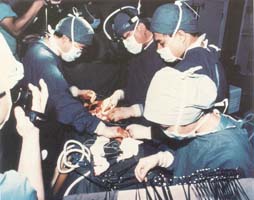Achievements
|
Cancer Centre The seven-storey Sir Yue Kong Pao Centre for Cancer and the Lady Pao Children's Cancer Centre integrates cancer diagnosis, inpatient and outpatient treatments, surgery, childrenˇ¦s bone marrow transplant unit, patient counselling and education, teaching and research under one roof. ˇ@ |
 |
|
Organ Transplant Organ transplant technology in Prince of Wales Hospital is internationally renowned. In 1984, the hospital pioneered ˇ§toe-hand transplantationˇ¨ in Hong Kong . In 1993, we performed the first live-related liver transplant surgery on a child patient in Southeast Asia, marking a milestone in the liver transplant history of Hong Kong . ˇ@ |
 |
Endoscopy Centre
The first Endoscopy Centre was opened in 1994 in Prince of Wales Hospital. Ever since, it has been recognized as a leading centre in Asia for endoscopic surgery. It also offers training to local and overseas professionals.
Skin Bank
Coping with burn wounds is a very painful experience. With the efforts of the Faculty of Medicine of the Chinese University of Hong Kong, the first comprehensive skin bank was established in 1992 in Prince of Wales Hospital, pioneering the use of artificial cuticle and pig skin to speed up the patientsˇ¦ recovery.
Assisted Human Reproduction Unit
In 1987, the hospital saw the birth of the first baby from Gamete Intra-fallopian Transfer in Hong Kong . We also introduced comprehensive screening for babies with suspected inherited metabolic diseases. In the following year, the Assisted Human Reproduction Unit succeeded in cryopreservation of human embryo. In 1990, the first set of twins resulting from Pronuclear Stage Transfer (PROST) Technique was born. In 1993, the hospital celebrated the birth of the 100th baby born from assisted production techniques. Another good news for infertile couples came in 1994 when the Department of Obstetrics and Gynaecology announced the delivery of the first baby born in Hong Kong as a result of micro-injection of human oocytes. This highly sophisticated technique, known as the sub-zonal insemination of oocytes (SUZI), enables the sperm to be placed directly adjacent to the cell membrane, thus increasing the chance of successful fertilization.


